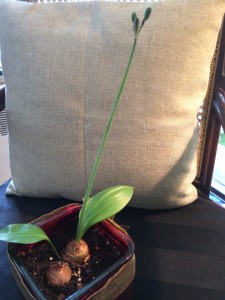tried to post picture… no luck with that. Have two bulbs and one is finally showing some signs of life:
Eucrosia bicolor
From Wikipedia, the free encyclopedia
Eucrosia bicolor
Gardenology-IMG 4845 hunt10mar.jpg
Scientific classification e
Kingdom: Plantae
Clade: Angiosperms
Clade: Monocots
Order: Asparagales
Family: Amaryllidaceae
Subfamily: Amaryllidoideae
Genus: Eucrosia
Species: E. bicolor
Binomial name
Eucrosia bicolor
Ker Gawl.
Eucrosia bicolor is a species of plant found in Ecuador and Peru. Its natural habitats are seasonally dry lowland areas. It was the first species of Eucrosia to be scientifically described, in 1816, and the first to be introduced into cultivation in Europe, flowering outside its homeland for the first time in 1817. It is the most widely grown species of Eucrosia.
It grows from bulbs up to 4.5 cm in diameter. The slightly glaucous leaves, which usually appear by flowering time, have short petioles and blades (laminae) which are 20 cm long by 10 cm wide. The flowers are umbellate, on a stem (scape) up to 60 cm in height, pale red in colour, with stamens with prominent long filaments. The stamens are yellow in the Ecuadorian var. bicolor and red in the Peruvian var. plowmanii.
When grown in cultivation in Europe, it should be kept dry at 10 °C or above when the leaves wither, and watered again when the flowers and leaves begin to appear in spring, when it should be kept in a sunny position.[1]
References[edit]
Jump up ^ Grossi, Alberto (2010), “Eucrosia in cultivation”, The Plantsman (New Series) 9 (4): 239–244, p. 241
Scientific classification e
Kingdom: Plantae
Clade: Angiosperms
Clade: Monocots
Order: Asparagales
Family: Amaryllidaceae
Subfamily: Amaryllidoideae
Genus: Eucrosia
Species: E. bicolor
Binomial name
Eucrosia bicolor
Ker Gawl.
Eucrosia bicolor is a species of plant found in Ecuador and Peru. Its natural habitats are seasonally dry lowland areas. It was the first species of Eucrosia to be scientifically described, in 1816, and the first to be introduced into cultivation in Europe, flowering outside its homeland for the first time in 1817. It is the most widely grown species of Eucrosia.
It grows from bulbs up to 4.5 cm in diameter. The slightly glaucous leaves, which usually appear by flowering time, have short petioles and blades (laminae) which are 20 cm long by 10 cm wide. The flowers are umbellate, on a stem (scape) up to 60 cm in height, pale red in colour, with stamens with prominent long filaments. The stamens are yellow in the Ecuadorian var. bicolor and red in the Peruvian var. plowmanii.
When grown in cultivation in Europe, it should be kept dry at 10 °C or above when the leaves wither, and watered again when the flowers and leaves begin to appear in spring, when it should be kept in a sunny position.[1]
References[edit]
Jump up ^ Grossi, Alberto (2010), “Eucrosia in cultivation”, The Plantsman (New Series) 9 (4): 239–244, p. 241
